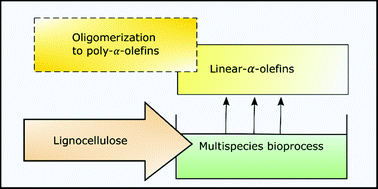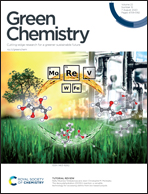Towards bioproduction of poly-α-olefins from lignocellulose†
Abstract
Bioprocesses involving more than one species can alleviate restrictions posed by limited substrate range of single species. Coupled, multistage cultures can be useful when heterogeneous substrates, such as lignocellulosic biomass, are exploited. Here, microbial production of α-olefins (C11) from lignocellulosic substrates, namely cellulose and technical lignin, was investigated. A two-stage culture with cellulose fermentation to organic acids by Clostridium cellulolyticum and subsequent upgrading of the organic acids to 1-undecene by engineered Acinetobacter baylyi ADP1 was established. As a result, A. baylyi ADP1 synthesised 107 μg L−1 of 1-undecene from cellulose. Additionally, ligninolytic effects by A. baylyi ADP1 on softwood were confirmed and downstream processing for continuous 1-undecene collection was introduced. In addition, the synthesis of poly-α-olefin trimers (C33) by the oligomerization of 1-undecene was demonstrated. This study demonstrates the potential of integrated multistage processes in treating challenging substrates.



 Please wait while we load your content...
Please wait while we load your content...